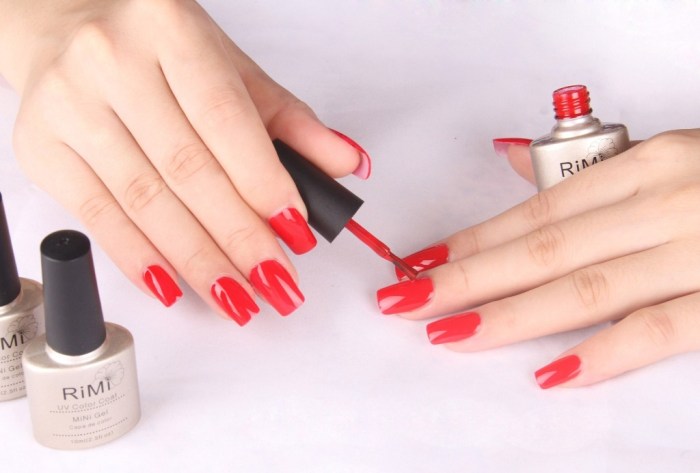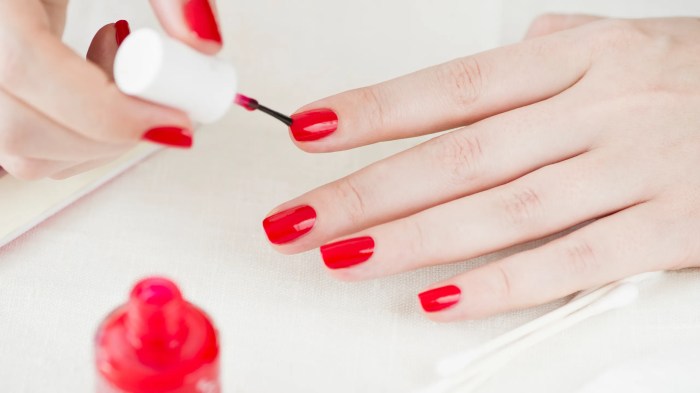How Do You Apply Nail Polish?
Preparing Your Nails for a Perfect Manicure

Source: guidebytips.com
How do you apply nail polish – Proper nail preparation is crucial for a long-lasting and beautiful manicure. Clean, dry nails ensure optimal polish adhesion, preventing chipping and smudging. Gently pushing back your cuticles helps maintain nail health and creates a smooth surface for application. Finally, shaping your nails complements your overall look and enhances the polish’s appearance.
Clean and Dry Nails, How do you apply nail polish
Begin by washing your hands thoroughly with soap and water. This removes dirt, oils, and lotions that can interfere with polish adhesion. Completely dry your nails before proceeding. Any remaining moisture can cause the polish to lift or bubble.
Gently Pushing Back Cuticles
Use a cuticle pusher or orangewood stick to gently push back your cuticles. Avoid aggressive pushing or cutting, as this can damage the delicate skin and increase the risk of infection. A soft touch is key to maintaining healthy cuticles.
Nail Shaping Techniques
Various nail shapes enhance the overall look of your manicure. Proper filing techniques are essential to achieve a clean and polished finish. Avoid sawing back and forth, as this can weaken the nails. Instead, use smooth, unidirectional strokes.
| Nail Shape | Description | Filing Technique | Image Description |
|---|---|---|---|
| Round | Soft curves, suitable for most nail beds. | File in a gentle curve, following the natural curve of the nail. | Imagine a smooth, rounded oval shape, extending slightly beyond the fingertip. The edges are softly curved, without any sharp points. |
| Oval | Similar to round, but slightly more elongated. | File straight across the tip, then gently round the corners. | Visually, this resembles an elongated oval, slightly pointed at the tip but still maintaining a soft, curved edge. |
| Square | Straight across the tip, with straight sides. | File straight across the tip, ensuring even length and sharp corners. | Imagine a perfect square, with the top edge aligned perfectly horizontally and the sides forming straight, vertical lines. |
| Almond | Tapered, pointed shape. | File the sides inward, tapering towards a soft point at the tip. | This shape resembles an almond, with a pointed tip and gently curved sides that narrow towards the point. The overall effect is elegant and sophisticated. |
Applying the Base Coat

Source: allure.com
A base coat is essential for protecting your nails from discoloration and promoting longer-lasting polish. It creates a smooth, even surface for the color coat, preventing staining and improving adhesion.
Base Coat Application
Apply a thin, even layer of base coat to each nail, starting from the cuticle and moving towards the tip. Avoid applying too much, as this can lead to streaking and clumping. Allow the base coat to dry completely before applying the color.
Drying Time
Typically, a base coat requires about 1-2 minutes to dry completely. However, drying time can vary depending on the brand and formula of the base coat. It’s crucial to wait until it’s fully dry to prevent smudging the color coat.
Applying nail polish involves several steps: prepping the nail, applying a base coat, then two coats of color, and finally a top coat for shine and longevity. However, improper application or using low-quality polish can potentially lead to nail issues. It’s worth considering that, as discussed in this article, can nail polish cause nail fungus , so maintaining good hygiene practices during application is crucial.
Therefore, always ensure your tools are clean and your nails are healthy before beginning your manicure.
Applying the Nail Polish
The proper technique for applying nail polish ensures a smooth, even finish. Using smooth, controlled strokes prevents bubbles and streaks, resulting in a professional-looking manicure. Applying multiple thin coats is better than one thick coat, which can lead to uneven drying and chipping.
Step-by-Step Nail Polish Application
The following steps detail how to apply nail polish effectively:
- Apply a thin coat of color polish to the center of the nail, starting about 1/4 inch from the cuticle. Drag the brush down to the tip in one smooth stroke.
- Apply another thin coat to each side of the nail, covering the entire nail bed. Use smooth, even strokes, working from the cuticle towards the tip.
- Carefully apply polish to the edges of the nail, sealing the edges to prevent chipping. This step is crucial for longevity.
- Allow each coat to dry completely before applying the next. Typically, two thin coats are sufficient for optimal color coverage.
Applying the Top Coat
A top coat seals the color, adds shine, and protects the manicure from chipping and wear. Choosing the right type of top coat can enhance the longevity and overall look of your manicure.
Top Coat Application
Apply a thin, even layer of top coat over the completely dry color polish, following the same technique used for the base coat and color coat. Avoid applying too much, as this can cause the top coat to become sticky or uneven.
Types of Top Coats

Source: whatthegelnails.com
- Quick-drying top coats: These significantly reduce drying time, perfect for busy schedules.
- Glossy top coats: Enhance the shine and vibrancy of the color polish, providing a high-gloss finish.
- Matte top coats: Create a smooth, non-shiny finish, offering a different aesthetic.
Dealing with Common Problems: How Do You Apply Nail Polish
Several common issues can occur during nail polish application. Understanding how to correct these mistakes helps achieve a flawless finish. Prevention is key, and understanding the causes of these problems can significantly reduce their occurrence.
Correcting Mistakes and Preventing Problems
- Smudges: If you smudge a wet coat, carefully apply a small amount of polish remover to a cotton swab and gently clean the affected area. Re-apply polish to the corrected section.
- Bubbles: Bubbles often result from applying thick coats or shaking the bottle vigorously. Apply thin coats and gently roll the bottle between your hands to mix the polish.
- Streaks: Streaks typically occur when the polish isn’t applied evenly. Use smooth, even strokes and apply multiple thin coats.
Removing Nail Polish
Proper nail polish removal protects your nails from damage. Using a gentle technique and appropriate remover minimizes the risk of dryness and brittleness.
Safe Nail Polish Removal
Saturate a cotton ball with acetone-free nail polish remover. Gently hold the cotton ball against each nail for a few seconds to soften the polish. Gently wipe away the polish, avoiding harsh scrubbing.
Precautions
- Always use an acetone-free remover to minimize dryness and damage.
- Avoid harsh scrubbing or excessive rubbing.
- Apply a cuticle oil or moisturizer after removing polish to replenish moisture.
Different Nail Polish Types
Various types of nail polish offer different finishes, drying times, and longevity. Understanding these differences helps you choose the best polish for your needs and desired look.
Nail Polish Types and Application
| Nail Polish Type | Description | Application Technique | Drying Time & Longevity |
|---|---|---|---|
| Crème | Classic, opaque finish. | Standard application technique; two thin coats are usually sufficient. | Average drying time; moderate longevity (3-5 days). |
| Shimmer | Contains fine particles that create a subtle sparkle. | Same as crème polish; may require slightly more coats for full coverage. | Similar drying time to crème; moderate longevity. |
| Glitter | Contains larger glitter particles for a more dramatic effect. | May require more coats for even glitter distribution; top coat is crucial to seal the glitter. | Slightly longer drying time; moderate to high longevity. |
| Gel | Requires a UV or LED lamp to cure; known for high shine and long-lasting wear. | Applied in thin layers and cured under a lamp after each layer. | Long drying time due to curing; high longevity (2-3 weeks). |
Q&A
What type of nail polish remover is best?
Acetone-based removers are generally the most effective, but they can be drying. Acetone-free removers are gentler but may require more effort.
How can I prevent my nail polish from chipping?
Apply thin coats of base coat, color, and top coat. Avoid using your nails as tools, and consider using a strengthening treatment underneath your polish.
How long should I wait between coats?
Allow each coat to dry completely before applying the next. This typically takes a few minutes, but drying time varies depending on the type of polish.
What should I do if I get a bubble in my nail polish?
If you notice a bubble while the polish is still wet, gently pop it with a toothpick or fine-tipped brush and smooth over the area.
















